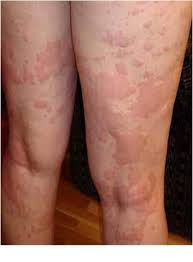
Chronic urticaria is classified as spontaneous if symptoms appear without a known specific trigger, and can occur as a single episode or repeated episodes.
Acute urticaria can progress the chronic spontaneous urticaria in less than 8% of cases.
Chronic spontaneous urticaria affects approximately one percent of the global population, most commonly females age 30 to 50 years.
Symptoms of chronic spontaneous urticaria last for at least three years in approximately 66% of patients.
Most patients with chronic spontaneous urticaria develop only wheals(57%) , 37% have wheals and angioedema, and 6% have only angioedema.
In some patients with chronic spontaneous to carry the disease can be exacerbated by stress, nonsteroidal, anti-inflammatory drugs and infections.
Cumulative estimates of spontaneous remission are 17% at one year, 45% of five years and 73% at 20 years.
Chronic spontaneous urticaria relapses in up to 1/3 of patients, with recurrence at five years in 17% of cases.
The presence of anti-thyroid antibodies, refractory is to antihistamines is associated with higher progression of acute to chronic spontaneous urticaria.
Because spontaneous attacks occur without identifiable triggers prevention is not possible.
Chronic spontaneous urticaria has skin mast cells as its primary driver.
Chronic spontaneous urticaria is primarily driven by degranulation of skin mast cells that leads to the release of pro-inflammatory mediators, including: histamine, leukotrienes, prostaglandins, platelet activating factor, cytokines, and chemokines.
In chronic spontaneous urticaria activation of BTK downstream of the high affinity IgE receptor in mast cells and basophils leads to release of histamine and other pro-inflammatory mediators that cause the symptoms of disease.
Activation of BTK is responsible for autoantibody production by B cells in chronic spontaneous urticaria.
In most patients with spontaneous chronic urticaria IgG and IgE immunity can occur and contribute to the activation and degranulation of skin mast cells.
Less than 35% of patients with chronic spontaneous urticaria have no autoantibodies.
The linking of IgG and IgE autoantibodies on skin mast cells activate cytoplasmic signaling proteins, resulting in the release of vasoactive substances, including histamine, the major contributor to urticaria symptoms, and cytokines, leading to activation of sensory nerves, vasodilation, and increased vascular permeability and migration of immune cells, such as eosinophils, T lymphocytes, and basophils into the skin.
The susceptibility to chronic urticaria may be determined by genetic factors, gut microbiome alterations and levels of short chain fatty acid producing bacteria.
With chronic spontaneous a carrier patients develop individual wheals, ranging from a few millimeters to several centimeters in diameter and typically appear and disappear within a single day, usually within a few hours, whereas angioedema typically lasts one to three days.
The wheals blanche, and can have irregular borders, change shape, and appear anywhere on the body.
Wheals chronic spontaneous urticaria most commonly occur on the arms, legs, and trunks, while associated angioedema commonly involves the face, especially the lips and eyelids, but can also affect other body parts in severe disease.
Among patients with chronic spontaneous urticaria and angioedema affects children less frequently than adults and female predominance may be less common in children compared with adults.
Treatment:
To control the signs and symptoms of chronic spontaneous urticaria therapy includes second generation H1 antihistamines, omalizumab, an anti–IgEmonoclonal antibody and cyclosporine.
Second generation H1 antihistamines include cetirizine, desloratadine, fexofenadine, levocentrizine, loratidine, rupatadine, blastine and eblastine.
Subcutaneous omalizumab is recommended for patients with chronic spontaneous urticaria who are age 12 years or older and whose symptoms persist despite use of high dose antihistamines.
The use of the immunosuppressant cyclosporine is recommended as third line therapy, as an add-on to antihistamines for patients with severe chronic spontaneous urticaria refractory to antihistamines and omalizumab.
The use of systemic corticosteroids is not recommended due to its long-term consequences.
Treatment with methotrexate, hydroxychloroquine, dapsone, plasmapheresis, and other immunomodulatory therapies are considered by specialists in patients with long lasting, severe and therapy refractory urticaria.
Additional agents for refractory disease include BTK inhibitors, anti-KIT, anti-IL-4R and anti-thymic stromal lymphoietin.
Treatment with oral remibrutinib a BTK inhibitor resulted in significant improvement in hives and itching at 12 weeks.
